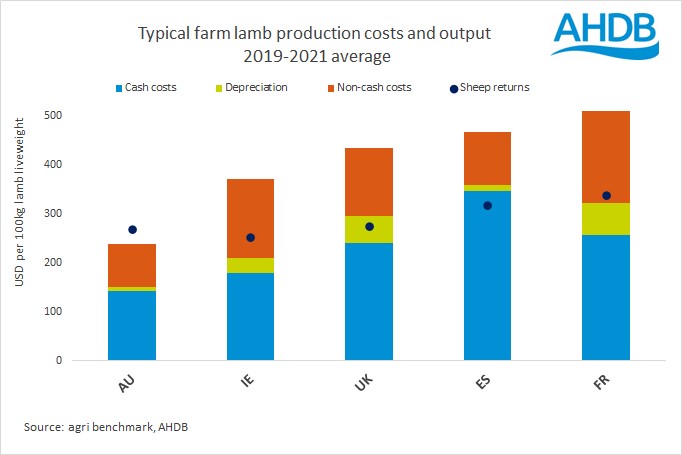- Home
- Lamb: international comparisons
Lamb: international comparisons
AHDB are part of the agri benchmark international network of 15 member countries who submit data for sheep “typical” farms.
This is an internationally standardised method of identifying and analysing typical farms representing typical production systems and their profitability, at farm level, in each country. The results are expressed in US Dollars (USD) as the international comparison base.
For more information visit the agri benchmark website
The UK trades and competes in a global market and is therefore affected by exchange rates as well as any competitive cost of production. The countries in the charts are representative of the UK’s main competitors and the exporting environment for commercial sheep meat.
The farms in these charts are ranked in ascending order of total costs. Cash costs include all paid expenses and non-cash costs include the value of family labour and rental value of owner-occupied land. Depreciation (machinery, equipment and buildings) is shown separately.
Returns do not include decoupled payments typically received by some farms, such as the EU land-based payments, nor the returns from any other farm enterprises.

Returns will include lambs sold for slaughter, for further finishing or breeding; cull and breeding ewes; and wool sales.
The farms selected for comparison are those whose aim is predominatly to produce finished (meat) lambs and are not typical of wool-producing flocks found in some of these countries.
The key differences are that Australia (and New Zealand who are not shown) do not house; graze outdoors all year round so have no need for conserved forage. The farmers have little equipment and they will have significantly larger numbers of sheep managed per full-time labour unit than UK farms.
In Ireland, most farms are managed part-time; there is little machinery investment and contractors are used for most tasks.
In Spain, the breeds are typically Merino resulting in added value to the wool and in parts of Spain the ewes may also be milked to produce cheese. However, higher input costs are largely due to the necessity to feed concentrates in both summer and winter due to the reduced grazing at these times of year.
Typically, most countries are practising rotational or paddock grazing by measuring and managing grass production. There are also examples, as in the UK, where sheep graze grass that has been introduced into an arable rotation (to reduce arable weeds such as blackgrass and to use forage crops and animals to improve soil health).
The UK have some of the highest numbers of lambs weaned per ewe with lowland farms averaging 1.6 lambs reared per ewe to ram and upland farms averaging 1.37 lambs reared per ewe to ram. On Australian farms lambs reared per ewe to ram is typically 1.32; in Ireland 1.39; in Spain 1.31 and in France 1.30.
All of the farms shown are typically aiming for lambs weighing 38-42 kgs liveweight at slaughter, except Spain who typically slaughter much lighter lambs.
Whilst New Zealand is not shown, from previous data and intelligence we know that their costs of production are lower than Australia. Australia usually have higher costs than New Zealand because of the impact of drought.

